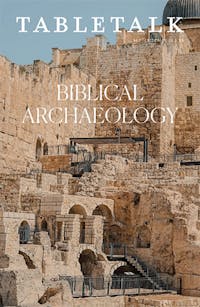
Request your free, three-month trial to Tabletalk magazine. You’ll receive the print issue monthly and gain immediate digital access to decades of archives. This trial is risk-free. No credit card required.
Try Tabletalk NowAlready receive Tabletalk magazine every month?
Verify your email address to gain unlimited access.
In 1979 on a ridge on the west side of the Hinnom Valley near Jerusalem, a group of twelve- to thirteen-year-old children were helping an archaeologist examine the remains of what had been a burial chamber; later quarrying activity had removed its roof. It contained burial shelves where bodies were laid to decompose and a repository under one of the shelves where bones and other artifacts were later deposited. They thought that the repository had been looted by grave robbers, but a boy sent to clean up the rock bottom decided to pound on it with a hammer instead and broke through it, exposing more than two feet of artifacts below. A portion of the roof of the repository had collapsed and created a false floor. Among the skeletal remains of around ninety-five individuals and various grave goods were found two somewhat corroded metal cylinders about the size of a cigarette butt.

They were plaques of silver with Hebrew scratched onto their surfaces, and they had been rolled so that they could be worn as amulets. Unrolled, the first was about one inch wide and four inches long with eighteen lines of writing with letters less than a quarter inch tall. The second was about half an inch wide by one and a half inches long, featuring twelve lines of writing with letters about an eighth of an inch tall. The writing was in the Paleo-Hebrew script that had been used in Israel until after the exile, when the square script borrowed from Aramaic became dominant. The amulets have been dated to the late preexilic time (late seventh or early sixth century BC) based on paleography (the form of the letters) and the archaeological context. The burial chamber was of the type used before the exile, and the amulets were in the back near the floor among the oldest, preexilic layers.
The scratched writing on the amulets is hard to read because of the state of the scrolls; parts of the edges are missing and cracked from being unrolled. It is clear, however, that both contain at the end a form of the priestly benediction found in Numbers 6:24–26. The first scroll also has a section that closely parallels Deuteronomy 7:9. Thus, they are the oldest known copies of a biblical passage, more than three hundred years older than the oldest Dead Sea Scrolls. As a whole, the amulets seem to contain a confessional statement of Yahweh’s power to protect His people, including the wearer, from evil.
